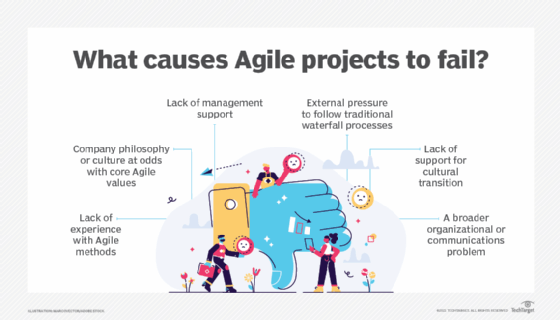
Getty Images
Emphasize culture in your Agile implementation approach
Team structure and culture should be a primary focus during any shift to Agile principles and methodologies.
Organizations recognize the need to adapt and innovate quickly to compete. Agile methodologies can help because they accelerate time to market, make development teams more efficient and reduce costs.
To build a successful Agile implementation approach, organizations should encourage group decision-making; self-managed, cross-functional teams; and a culture that values open communication and feedback.
The benefits of Agile methodologies
Agile enables an organization to be dynamic, flexible and resilient. As a result, the company can adapt to unanticipated challenges, events and opportunities.
Some Agile advantages are the following:
- Faster time to market. Traditional development practices demand a significant amount of time to build, test and deploy software. By the time software is released, it may not meet business requirements or generate the expected revenue. Agile considerably reduces time to market, facilitating software releases when they're most relevant.
- Early ROI. With shorter development cycles and faster product deployments, Agile yields quicker ROI compared to conventional approaches. Consistent updates help generate revenue and keep end users satisfied.
- Customer satisfaction. Agile treats users as equal partners in the development process, and a product owner facilitates user-developer collaboration. These methodologies prioritize users' requests and ensure they are pleased with the outcome.
- Better product quality and productivity. This process improves software quality, since teams can detect and fix issues early and quickly. Developers receive early feedback on the software, which minimizes the chance of building a low-quality product. In addition, teams complete projects in shorter time frames -- known as sprints -- so those projects are easier to manage.
- Improved work culture and morale. Agile fosters a culture of fun, learning and open communication, all of which help team members and organizations grow. Teams engage in continuous learning, which helps them advance their careers and boosts morale.
An effective Agile implementation approach fosters an atmosphere of shared responsibility that makes the workplace more enjoyable.

Organize an Agile team
Agile teams are often organized around product features and components. The team, as a whole, focuses on how to deliver continuous value to the user, and team members have the ability to work independently without a structural hierarchy.
Also, Agile teams can self-organize to meet project goals and complete work within predetermined timelines. The specific structure isn't a concrete concept within Agile development. A group should consider elements such as project complexity, deadlines and staffing to determine how best to organize a team.
Build a sustainable Agile culture
Another integral part of an Agile implementation approach is to build a sustainable and valuable internal culture. Organizations can perform the following tasks to foster this culture:
- Gather regular feedback to assess progress and value.
- Foster an environment of recognition, trust, transparency, collaboration and continued learning.
- Invest in tools and technologies that support Agile initiatives -- such as team collaboration tools, including Jira, Pivotal Tracker and Asana -- and train staff how to use them.
- Build an innovative, but stable, organization with strong leadership to reinforce Agile ideals.
- Identify and eliminate any causes of waste and delay.
Before any Agile implementation, ensure that your organization is ready to make a foundational shift toward a new culture and mindset.








